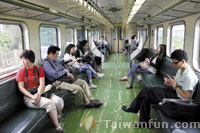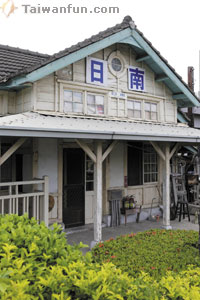
Passengers can pick any seat
they want on local trains,
which
usually offer plenty of
space if it's not during rush
hours.

Qingshui Station is one of the
oldest structures inTaichung.

The U-shaped classrooms at
Qingshui
Elementary School
have been restored
with color-
glazed roof tiles.

Qingshui Elementary School
has a beautiful
vintage red-
brick bell tower.

The Seaport Art Center is built
with a Minnan architectural
style, and locals love to linger
here during holidays.

The well-known Qingshui Rice
Tube Pudding is a big favorite
among visitors.

The small, delicate-looking
Dadu Station has a
very simple
exterior.

Huangsi Tutorial Academy worships Wen Chang
Dijun
who is the Daoist God of
Culture and
Literature.

Students pray to Wen Chang
Dijun
for good grades.

The wooden Zhuifen Station
got its name because it is
located
at the intersection of
the mountain and coastal rail
lines.

Rare hard-card tickets
with
special stamps are
very popular
souvenirs.
|
A relaxing exploration of
coastal Taichung by train:
Exploring historic spots, savoring delicious
cuisine and riding bikes
Words by Wu Xiu-yun
Photography by Yang Zhi-ren
Translated by Angel Pu
Rinan Station→Dajia Station→Taichung Port Station→Qingshui Station→Shalu Station→Longjing Station→Dadu Station→Zhuifen Station
Every time I take the train, the views passing by outside the windows
always make me feel peaceful and calm.
During this hot summer season, jump on a train and visit the coastal
areas with an relaxed spirit.
Do you know which rail line is closest to the Taiwan Strait? It's the Zhunan-to-Changhua section of the North-South Railway--normally referred to as the coast line. Although it doesn't always follow the coast, it passes through many seaside villages that are still full of vintage spirit and atmosphere. There are eight stations along the coastal line in Taichung city and every one of them still maintains its own unique style. Among all of them, Rinan and Zhuifen are wooden stations which were built by the Japanese colonial government, making them precious historic structures. There are also many eateries, historical sites and the Taichung City Seaport Art Center near the stations, which is convenient for tourists. The area surrounding the small but exquisite Dadu Station is suitable for riding bikes to the nearby Huangsi Tutorial Academy or along a bikeway while enjoying beautiful rice paddy scenes. Of course, you can't miss important Taiwanese religious center Dajia district. Must-visit places there include the Jenn Lann Temple and the old neighborhood, and don't forget to buy some gifts for family and friends while you're visiting.
Rinan -- A coastal railway treasure for rail fans
The rail journey starts at the northernmost Rinan Station. As soon as you get off the train, you'll see the old station, built in 1922. The combination of black roof tiles and white walls is very antique-looking and has a soothing feel to it.
 
Left: Located in northern Dajia district,
the wooden Rinan Station is over 90 years old.
Right: When the passengers exit the
station, they will dump their
tickets back in the recycling box.
Rinan Station is located in Dajia district, and only local trains stop there. According to the railway fans, it is one of the "five treasures of the coastal line railway" together with Tanwen Station, Dashan Station, Xinpu Station and Zhuifen Station, which are all officially-recognized historic sites. The waiting room of this station has a high wooden ceiling and is made of wood. The most vintage-looking part is the ticket window with its mottled old paint and wooden fences for keeping lines apart. Altogether, this station has served train passengers for 89 years.
On weekdays, most of the passengers are commuters, but the station fills up with tourists and railway fans every holiday. At this station, watching passengers get on and off the trains, and standing on the platform to admire the old structure always allows one to soak up a bit of its vintage atmosphere.
Dajia -- A religious place
There is no way that you can visit the religious center of Dajia without stopping by the well-known Jenn Lann Temple, perhaps to pay respects to the goddess Mazu and pray for a safe trip. The town is always full of worshipers and visitors, mainly because of Mazu.
Dajia was once famous for making straw hats, so after you visit Mazu, shopping in the old neighborhood and buying a Dajia crispy butter cake, you should go and see how they make one of Dajia's traditional handicrafts--triangular-rush woven products such as rush mats and rush hats. You will be impressed by light fragrance and exquisite handiwork of these products.
Qingshui -- A small town with many tourist attractions
As we reboard the train our next stop is Qingshui--a major station along the coastal railway. Everything at this station reminds you of the good old days--the outside walls with yellow brown tiles, the rounded pillars inside the main hall, and the smoothly-curved cast-iron waiting chairs--the entire structure's style is simple but beautiful. Qingshui Station was originally built of wood, but a major earthquake in 1935 destroyed it. The rebuilt Qingshui Station has now become one of Taiwan's most important historic sites. In the 100 Historic Sites in Taiwan selection organized by theCouncil for Cultural Affairs in 2001, Qingshui Station earned 14th place and was also selected as one of the top 10 historic sites of the former Taichung County in October the same year.
The Qingshui Elementary School is over a hundred years old and its U-shaped classrooms, built in 1935, are delicately designed. Despite the earthquake that struck that same year just after it was built, the structure survived. When the 921 Earthquake occurred in 1999, the elementary school also remained standing. After this surviving of two major earthquakes, Qingshui Elementary School has officially become an earthquake memorial building. The Cultural Affairs Bureau and Council for Cultural Affairs helped to repair slight damage, and it became the first school to be designated a historic site.
Next we come to Zihyunyan Temple, which is also known as the Guanyin Pavilion. This is not only a religious center for local residents, but also a Buddhist sacred place for visitors and pilgrims. Aofeng Mountain Township Park (which the locals like to call Qingshui Park or Aofeng Mountain Park) has many kinds of natural scenery. The Niu-Ma-Tou Cultural Site within the park is where Cord-Marked Pottery and several historic relics were found. These relics have completed Central Taiwan’s human development history and are representative of Taiwan's Neolithic Age culture.
There’s one delicacy that you must try when you visit Qingshui, Qingshui Rice Tube Pudding, considered its most famous food. Restaurants known for making rice tube pudding include Wang Ta, A Cai, and Rong Ji. After satisfying your stomach, why not go to the Seaport Art Center to appreciate some fine arts and culture? As soon as you enter the center, you'll encounter a wide-open space along with Minnan-style architecture and large sculptures, expressions of the center design's rich artistic environment.
Dadu -- A little station with the mingled scent of rice and books
Stepping out of the small Dadu Station, you can head toward the nearby bikeway and Huangsi Tutorial Academy in an experience that offers both the scents of rice and books. The bikeway starts from the irrigation association in Yingpu Village and ends at Huangsi Tutorial Academy. Along the way you can enjoy scenery of vast green rice fields and, sometimes, passing trains on the coastal railway.
The academy at the end is located on WenChang 1st Street. Built in 1888, it has been dedicated to developing local education. This Minnan-style building has elegant red-brick roof tiles and splendid "dove-tailed" eaves, which are classic building design elements from the Qing dynasty. Although this is an academy, there is a Wen Chang Temple worshipping Wen Chang Dijun (God of Culture and Literature) here, which explains visits by many students praying for good results before big exams.
Zhuifen -- The intersection of mountain and coastal lines
The final destination on this trip is Zhuifen, which joins Rinan Station as one of the "five treasures of the coastal line railway". The whole station is a wooden structure, giving it a very calm, elegant appearance. Zhuifen and Rinan stations were both constructed in 1922. "Zhuifen" means "bifurcation point" in Japanese, as this is where the mountain line and coastal line cross. If you head south from this station, you will come to Changhua county and if you head north and pass through Chenggong Station you will connect to the mountain line railway to reach Taichung and Fengyuan.
Besides its precious wooden structure, Zhuifen Station is also one of the stations that still issue hard card-style tickets. In this modern age of technology, these vintage tickets have become precious souvenirs for railway fans and also have fortuitous meanings for others. For example, "Zhuifen Station - Chenggong Station" has a double meaning of "academic success" in Chinese, while "Dadu Station -- Chenggong Station" means "successfully pregnant". These are among the many fascinating tickets that local rail fans appreciate.
Now's the time to pack your bag and embark on a coastal line railway trip! You will discover how charming it is as you forget about the restraints of time and forge new connections with local culture and the rich past.
◆
For train schedules, please visit the official website of Taiwan
Railway Administration.
◆
Qingshui Elementary School: 123, GuangHua Rd, Qingshui
District
◆Taichung City Seaport Art Center: 21, ZhongZheng Rd, Qingshui
District. Tel: (04) 2627-4568. Closed Mondays and national
holidays.
◆Huangsi Tutorial Academy: 10, WenChang 1st St, Huangsi
Village, Dadu District
|